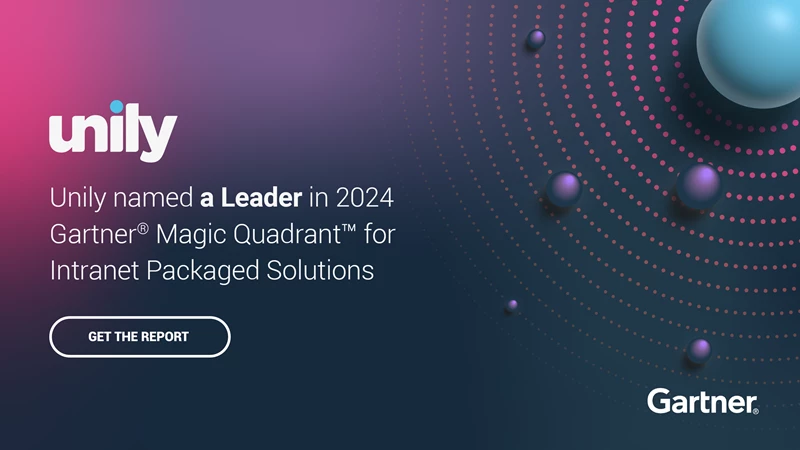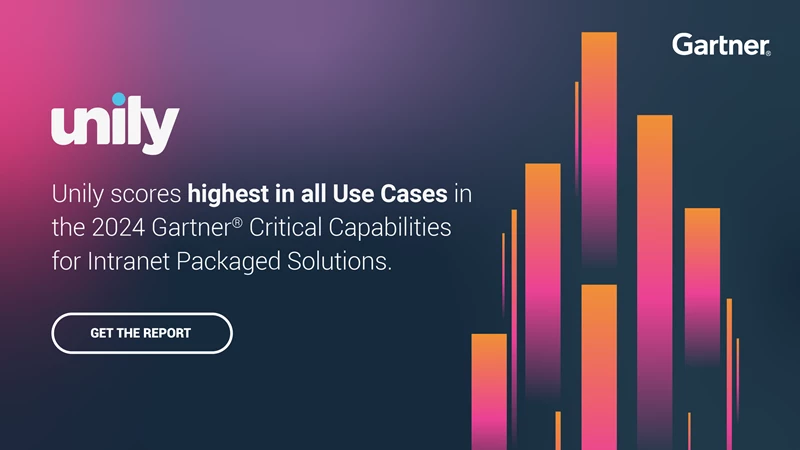The cost of an intranet: Not upgrading to a modern EXP is costing large enterprises $25 million per month
Today, large enterprises need to enhance productivity, streamline communication, and stay ahead of rapid market changes to keep talent and remain competitive. But many organizations still overlook the critical component that significantly impacts these objectives: their intranet or employee experience platform (EXP). An outdated intranet can cost businesses in more ways than they realize—from productivity losses to missed opportunities for employee engagement and innovation.

Looking at the statistics collected for this article, the estimated cost of not upgrading to a modern EXP is huge. For an enterprise with 10,000 employees the impact could be $25.13 million per month.
This estimated figure is based on a company of 10,000 employees, with an average wage of $75,000, and a turnover of $500,000,000. We have estimated that poor customer satisfaction can impact revenue by 5% per year (Qualtrics 2021 even estimate that brands risk losing 9.5% of revenue as a result of bad customer experience) and stifle innovation by 1% (PwC, McKinsey, HBR, and Deloitte estimate growth rates are 2-10x higher for top innovators).
The real costs of an outdated intranet:
The longer it’s left, the harder it is to reverse the damage.
A modern EXP is more than just a portal for company news or a repository for documents. It is the nerve center for communication, collaboration, information management, and access across an organization. When the intranet is outdated, employees often struggle to find the information they need quickly, leading to significant productivity losses.
According to a study by the McKinsey Global Institute, employees spend nearly 20% of their workweek - about 1.8 hours every day - searching for and gathering information. This translates to approximately $50.7 million in lost productivity per year for a company with 10,000 employees. This is purely from employees searching for and gathering information.
But it’s not just about time wasted; it’s also about the cost of lost opportunities. Modern intranets improve employee engagement through improved communications, collaboration, and community. Given that highly engaged employees are 17% more productive and result in 21% higher profitability, according to Gallup, the financial impact of a modern intranet is undeniable.
The costs of maintaining an outdated intranet extend beyond direct financial losses or lost opportunities. The longer an organization delays upgrading its intranet, the harder and more expensive it becomes to reverse the damage.
Here are some hidden costs:
1. Employee frustration and turnover
An outdated intranet can be a significant source of frustration for employees. Outdated UX, poor search functionality, lack of mobile accessibility, and slow performance can make daily tasks more cumbersome. More than one in three US employees are frustrated with their technology at work according to research conducted by Eagle Hill Consulting.
Unily’s latest research, ‘The Digital Noise Impact Report’, discovered that nearly half of all employees are distracted at least once every 30 minutes, and almost a third report being distracted at least once every 15 minutes by a workplace notification. That means employees working 8-hour days could be experiencing over 160 distractions from their workplace digital tools each week.
Distractions and frustration with technology is a key factor in job dissatisfaction, which can lead to increased turnover rates. Given that the cost of replacing an employee is about 33% of their annual salary, according to Employee Benefit News, high turnover can result in significant costs for organizations.
2. Missed opportunities for innovation
A modern intranet is a platform for innovation and collaboration, enabling employees to share ideas, work on projects together, and build on each other’s knowledge. An outdated intranet can stifle this innovation by making it harder for employees to collaborate effectively. A joint study between the Institute for Corporate Productivity (i4cp) and Rob Cross, Edward A. Madden (Professor of Global Business at Babson College) found that companies that promoted collaborative working were 5x as likely to be high performing. Failing to upgrade your intranet could mean missing out on these opportunities for growth and innovation.
3. Decreased customer satisfaction
An efficient EXP engages and motivates while providing fast access to resources. An outdated intranet results in a demotivated workforce and knowledge that is difficult to utilize. These weaknesses result in delayed responses, missed communications, and poor coordination among teams, leading to a decline in customer satisfaction.
Luxury hotelier Kerzner use their Unily EXP to provide rapid, centralized access information for to hotel staff. Easy access to knowledge enables all hotel staff to provide great customer service by answering any guest question, even if it sits outside of their remit.
The link between customer experience (CX) and employee experience (EX) is undeniable, with Salesforce sharing research that 89% of customers are more likely to make another purchase after a positive customer service experience, highlighting the critical importance of internal efficiency on external outcomes.
The cost of delaying: Damage that grows over time
The longer an organization delays upgrading its intranet, the more difficult it becomes to catch up. Here’s why:
Technical debt accumulates
As time passes, the technical debt - the implied cost of future fixes - accumulates. Older platforms often lack compatibility with newer systems, making future upgrades more complex and costly. Outdated intranets often have huge costs associated with any new integrations, development, and ongoing training. According to Deloitte, CIOs report the majority of their technology budgets are allocated to support business operations (57%), compared with only 26% to fund incremental business change. Maintaining legacy systems is also a costly burden, with an average of 60-80% of IT budgets allocated to keeping them running (Audacia). The burden of technical debt hanging over large enterprises leaves little to no room for much needed innovation.
Talent acquisition and retention challenges
As younger, tech-savvy generations enter the workforce, they expect modern, intuitive tools to do their jobs effectively. Organizations that fail to modernize the look and feel of their intranet risk being seen as outdated, making it harder to attract and retain top talent. According to LinkedIn's Workforce Learning Report, 94% of employees would stay longer at a company that invests in their career development, which is increasingly tied to access to effective digital tools.
Widening competitive gap
As competitors modernize their internal systems, they become more agile, innovative, and responsive to market changes. Enterprises that fail to upgrade risk falling further behind, not just in terms of internal efficiency but also in their ability to pivot to market changes and deliver value to customers. The longer this gap persists, the harder it will be to catch up.
Why upgrading to an EXP should be a priority
Modernizing your intranet is not just a "nice to have"; it’s a strategic investment that pays off in multiple ways:
Improved employee experience
A modern EXP offers user-friendly interfaces, social community and collaboration tools, and mobile access, which are vital in today's hybrid and remote work environments. Organizations that prioritize employee experience are 4x more profitable than those that don’t, according to the Deloitte Global Human Capital Trends report.
Enhanced communication and collaboration
With fast access to knowledge and multi-channel personalized communications, a modern intranet helps break down silos, improve cross-functional collaboration, and foster a culture of transparency and engagement. According to McKinsey, companies with effective communication strategies are 3.5x more likely to outperform their peers.
Data-driven decision-making
A modern EXP offers comprehensive advanced analytics capabilities, enabling organizations to measure engagement, track content performance, and make data-driven decisions to continuously improve the platform and meet employees’ needs. By leveraging analytics, companies can identify bottlenecks and inefficiencies, ultimately driving productivity gains.
Future-proofing against technological advancements
A modern intranet is flexible and scalable, making it easier to integrate with future technologies such as artificial intelligence, machine learning, and automation tools. A modern EXP enables large enterprises to utilize automation and agents for AI assisted work, while also respecting their governance and security requirements. Investing in a scalable solution today can save significant costs associated with overhauling the system again in the near future.
Conclusion: The Time to Act is Now
The decision to upgrade an intranet should not be delayed. The estimated cost of not upgrading to a modern EXP is huge. For an enterprise with 10,000 employees, it is estimated to be $25.13 million per month. This figure reflects the cumulative impact of lost productivity, employee turnover, missed innovation opportunities, and decreased customer satisfaction. By prioritizing the upgrade to an Employee Experience Platform, enterprises significantly reduce costs and improve organizational velocity.
The longer you wait, the greater the risks and costs. Enterprises that adopt an intranet modernization strategy will transform the digital fabric of their organization into a powerful enabler of business success.
Get started. Get your personalized demo.
Reinvent your intranet for the employee experience era.
-
Event

















